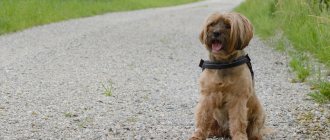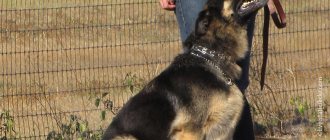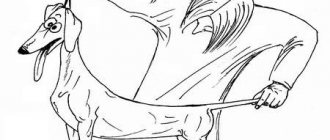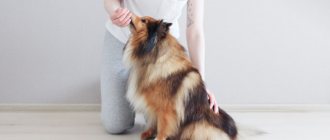A command such as “fu” must be taught to your puppy from the very beginning of his stay in your home. If you purchase an adult dog, you can train him, but this will simply require much more time and effort on your part. If you have problems teaching this command to an adult dog that is accustomed to a no-holds-barred lifestyle, you should seek help from a dog trainer.
The Importance of Restrictive Commands
Training of the “No” and “Fu” commands is mandatory for dogs attending the UGS and OKD. They were included in basic training courses for a reason. With the help of these orders, the owner imposes prohibitions on the following actions:
- picking up from the ground, which is fraught with gastrointestinal problems and fatal poisoning;
- causeless barking that accompanies any rustle;
- jumping on people as a greeting, leaving dirt and claw marks on clothes;
- manifestation of aggression towards family members and harmless passers-by (children, cyclists) who do not want to harm the owner;
- damage to property and relieving yourself in the wrong place;
- attack on attackers who do not pose a threat at the moment;
- taking food before the specified time;
- snatching a toy from the owner’s hands without obtaining appropriate permission;
- entering the room before a person does.
If the purpose of imposing a ban is to develop a long-term habit, then be sure to follow the rules you set. Punish your pet not only for picking it up on the street, but also for any attempts to “vacuum up” crumbs that have fallen on the floor.
Buy active toys
Active toys are the type that your dog is likely to spend a long time with. These toys are usually made of very hard rubber.
or thick rope, they can be carried with you and chewed without being destroyed.
Some use rawhide toys instead, but these can easily create a choking hazard as the dog bites off small pieces. Hard rubber toys may offer a safer option.
Tennis balls are also a common option for active toys. However, keep an eye on your dog and give it only special balls, specifically for dogs.
their coating is not so abrasive, it does not wear down your pet’s teeth.
The KONG Gyro toy will delight your dog with fun flips and rolls.
The difference between “Fu” and “You can’t”
Some owners use either the “Fu” command or the “No” command to train their dogs. This approach is incorrect, since these orders differ significantly from each other:
- “Fu” is used for a total ban. This includes picking up and attacking passers-by. Neglecting this order is unacceptable in any situation, regardless of extraneous factors.
- “No” prohibits actions for a short time. This order is used when they do not want the dog to approach a certain guest or start eating before the bowl is completely filled.
Teaching the second skill is more difficult, since the animal must not only understand the prohibition, but also the orders that allow it to say, “Take”, “You can”. For this reason, it is added to the training course after the dog has been taught the “Fu” command.
Useful tips
Sometimes you have to use an electric collar
Many experts recommend using "Foo" only in the most extreme cases - to prevent fighting with other dogs, attacking people, or eating garbage. The command is categorical and should be used as rarely as possible.
For training, you can artificially simulate the situation - for example, go to a place where other dogs go or there are definitely things that your pet wants to eat.
Optimal age for training
Training the "Fu" command is suitable for dogs older than 2-3 months. Most often, the first training is carried out shortly after separation from the mother, that is, after moving to a new place of residence. At this age, the psyche of puppies is very vulnerable, so the most optimal form of exercise is play.
With the help of prohibitions, the child should immediately define the boundaries of what is permitted. The further behavior of the animal will depend on the quality of training. The same applies to adult pets. The only caveat in their case is a longer learning process, due to the presence of established habits.
Reaction to shots
Х¾ÃÂþÃÂþ þñÃÂÃÂõýýðàÃÂþñðúð ýõ ôà ñþÃÂÃÂÃÂÃÂàóÃÂþüð, ò÷ÃÂÃÂòð ÿ õÃÂðÃÂô, òÃÂÃÂÃÂÃÂõûþò øûø ûÃÂà±Ã¾Ã³Ã¾ ôÃÂÃÂóþóþ óþÃÂþôÃÂúþóþ ÃÂàüð. ÃÂÃÂøÃÂÃÂðÃÂàÿøÃÂþüÃÂð ú óÃÂþüúøü ÷òÃÂúðü üýþóøõ ýðÃÂøýðÃÂààÃð üþóþ ÃÂðýýõóþ òþ÷ÃÂðÃÂÃÂð.
ÃÂðú ÿÃÂðòøûÃÂýþ ÃÂÃÂþ ÃÂôõûðÃÂÃÂ, ü þöýþ ÿÃÂþÃÂøÃÂðÃÂàò ÃÂÃÂðÃÂÃÂõ â çÃÂà ôõûðÃÂÃÂ, õÃÂà»Ã¸ ÃÂþñðúð ñþøÃÂÃÂàóÃÂþüúøà÷òà Âúþò.
ÃÂÃÂýþÃÂõýøõ öøòþÃÂýþóþ ú òÃÂàÃÂÃÂõûðü ÿÃÂþòõÃÂÃÂÃÂàÿÃÂø òÃÂÿþûà½ÃµÃ½Ã¸Ã¸ òÃÂõàýðòÃÂúþò ÃÂÃÂÃÂ, úÃÂþüà úþüðýô âÂÂàÃÂôþüâ ø âÂÂÃÂÿþÃÂÃÂâÂÂ. ÿÃÂþø÷òþôøÃÂÃÂàø÷ ÃÂÿàine 15 þûýÃÂÃÂÃÂõù úþüðýôàÃÂþñðúø.
ÃÂÃÂûø ÿøÃÂþüõàÿÃÂõúÃÂðÃÂðõàòÃÂà ÿþûýõýøõ úþüðýô, ÿÃÂóðõÃÂÃÂÃ à ¸Ã»Ã¸ ÃÂñõóðõÃÂ, ýðòÃÂú ýõ à·Ã°ÃÂÃÂøÃÂÃÂòðõÃÂÃÂÃÂ.
How to teach a dog or puppy the “No” command
Effective training is based on the sequence: attempt to perform an unwanted action - prohibition - influence. To practice the skill, follow the algorithm below:
- If your pet loves to greet guests, but one of his friends has allergies, then say “No” as soon as the puppy tries to sniff him.
- If your four-legged dog stubbornly ignores you and is still trying to get to know you, repeat the prohibition and gently grab him by the scruff of the neck. Take your baby to the lounger and say “Place.” After completing the order, be sure to give him a treat.
- Repeat the previous steps every time the baby tries to jump on the unfortunate allergy sufferer.
Actions will vary depending on the goal being pursued. If you want to teach your pet not to rush at guests before they take off their shoes and outerwear, maintain the ban until the right moment and command “It’s OK.” After this, each of the guests can praise and hug the baby.
How to teach a dog or puppy the “Fu” command
If you understand how to teach a dog the “No” command, then there will be no problems with “Fu”. A similar algorithm is used here:
- Place a few treats on the floor that are sure to attract the attention of your four-legged dog. Place them in different rooms.
- Put a collar and leash on your pet. It is better to do the first training at home. You can move on to outdoor exercise when the animal begins to respond to verbal orders.
- Lead your dog to the treat and make sure he notices it. If he stubbornly tries to grab the treat, say “Ugh” and pull on the leash.
- If your pet doesn’t listen to you, repeat the previous step again. If this does not work, then use light physical pressure. To do this, gently slap the rump with a magazine. Unlike the already familiar jerk of the leash, the blow will be unexpected, so with a high probability the four-legged person will turn away from the prohibited object.
- Go with the dog to another room for a new treat and repeat the previous steps. It is recommended to perform 5 exercises per workout, remembering to pause for at least 10 minutes.
As soon as your pet starts listening to you, feel free to go outside. A little later, training can be complicated by the lack of a leash, new prohibited items and the involvement of strangers. The last option is recommended for weaning off treats from the hands of a stranger.
Common mistakes and prohibited tricks
For beginners teaching dogs the “Foo” and “No” commands on their own, it is very important to become familiar with common mistakes in advance. These include:
- Availability of incentives. Praise is good, but it should be used only for its intended purpose.
- Misuse of restraining orders.
- Frequent tugging on the leash. Impact is an additional technique, not the main one. Ideally, the dog should respond to your orders on its own.
- Lack of breaks or studying too long.
- Simultaneous training of several skills at once.
- Training by only one family member.
- Submission of order too late.
- Termination of training after successful completion of several orders. Due to short-term memory, the animal quickly forgets unpleasant actions.
Prohibited methods include painful physical impact, screaming and deprivation of vital things (food, water, walks). All of this can lead to severe injury and destructive behavior.
Tips from dog handlers
In the end, it’s worth giving a few tips from dog handlers that will simplify training and make it more effective:
- When training disobedient dogs, additional stimuli should be used - from electric collars to dog whistles.
- It is advisable to combine the execution of the order with the command “Come to me!” to reduce the risk of repeated violation.
- The command must be carried out when given by any family member - otherwise it will be very difficult to control the dog.
By fulfilling all these conditions and properly training a pet that has recently appeared in the house, the breeder will certainly be able to save himself and the pet from many problems in the future. Therefore, you should not neglect this precise command.
What to do if the animal does not obey?
If there is no result for a long time, make sure that you have not made the mistakes listed above. If they are there, correct them, and if they are not there or you don’t notice them, sign up for classes with a dog trainer.
Troubleshooting
Once you are sure that the problem is with you, try to eliminate the reason that is inhibiting the consolidation of the skill. To do this, use the following recommendations:
- Use exclusively negative reinforcement. Praise encourages action, not the other way around. The only acceptable incentive for prohibition is the absence of punishment.
- Use “Fu” and “No” exclusively for their intended purpose, that is, for permanent and temporary prohibition.
- Don't abuse the leash. It is effective only at the very beginning of training.
- Do not complete the approaches at once and be sure to dilute the training with joint games.
- Take your time to complete the basic program over a certain period of time and allow your pet to go at a pace that is comfortable for him.
- Involve all family members in training your pet.
- Prohibit an action not after it has actually been committed, but as soon as possible. If the dog pees in front of you, then it’s too late to say “Ugh.” A guilty pet can only be scolded, but a ban should be imposed when he is just looking for a place to settle down.
- Conduct reinforcing training at least 2 times a month so that your pet does not lose the acquired skill.
An equally important point is a good mood. Inhibitions are always stressful, so do not overload sick, tired or depressed animals until they return to normal.
Basic rules of training
When starting to train your pet with basic prohibition commands, you need to follow these rules:
- It is advisable to conduct training sessions with your dog outdoors. You should choose a secluded place where there are few distractions: cars, people, other animals. There is no need to remove plastic bottles and other garbage - it will be useful for training. Just make sure that there are no dangerous objects among the scattered objects.
- It is better to choose different places for training, then the dog will carry out the command anywhere after the end of training.
- During training, your dog should be wearing a leash and collar so that you can fully control him.
- When practicing the “Fu” and “No” skills, the animal is not rewarded. If the owner is satisfied with the training, he can give him a treat after training.
- If you forbid your pet to take any objects from the ground or pester people or other animals, always do this. You cannot first restrict a dog from certain behavior and then allow it. Then the commands will lose their meaning.
- If an animal starts playing and gets into a fight with another dog, you won’t be able to stop it with an order. It is necessary to force the dogs away or take away an unnecessary item from the pet.
- Do not use the same objects to practice the command “No” as for “Fu”. Otherwise, the puppy will not be able to perform any of these tasks correctly.
Exercises with your pet should be done regularly. Spend a few hours a week working on these skills and you will succeed.











